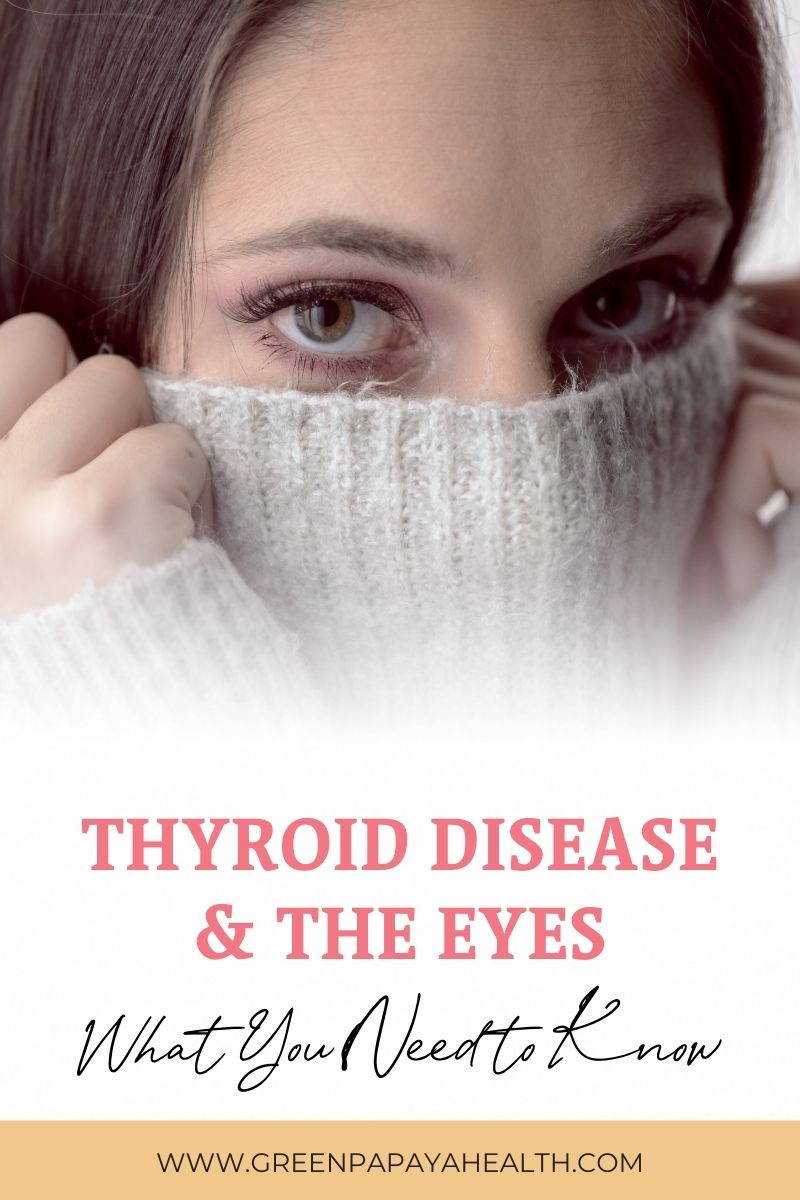Thyroid disease affects the body in many ways, but eye problems are a lesser-known symptom of having an overactive or underactive thyroid gland. Hypothyroidism, for instance, can sometimes cause the skin around the eyes to swell (known as periorbital swelling) — and other eye-related symptoms may include blurred vision, eyelid abnormalities, watery eyes, grittiness, and eyebrow hair and eyelash loss. Additionally, those with Hashimoto’s thyroiditis (autoimmune thyroid disease) are more likely to develop dry eye syndrome than those without thyroid problems.
For individuals with an overactive thyroid gland, hyperthyroidism and Graves’ disease are more commonly associated with an autoimmune disorder known as Graves’ ophthalmopathy. Also referred to as thyroid eye disease (TED) or thyroid-associated orbitopathy (TAO), symptoms of this autoimmune condition often include bulging eyes, excessive tearing, double vision, and light sensitivity. Dry eye syndrome can also occur, and in rare cases, thyroid eye disease may cause vision loss.
Typically, symptoms of TED develop within six months of receiving a diagnosis of Graves’ disease. Some patients are diagnosed with Graves’ disease and TED during the same doctor’s visit, but in other cases, an MRI or CT scan may be needed in order to take a closer look at the patient’s eye muscles. And while symptoms of thyroid eye disease can occur in those without an overactive (or underactive) thyroid gland, thyroid-associated orbitopathy is more common in those with Graves’.
If you’ve been diagnosed with Graves’ disease, be sure to tell your eye doctor. Schedule regular eye examinations so your doctor can monitor your eyes for symptoms such as swelling, bulging, and misalignment.
How Does the Thyroid Gland Affect the Eyes?
Though eye problems are more commonly seen in patients with Graves’ disease, about six percent of patients with Hashimoto’s thyroiditis are affected by thyroid-associated eye disease — specifically symptoms such as bulging eyes, eye dryness, and redness. The risk is greater in older patients, heavy smokers, and those who’ve had Hashimoto’s for several years.
Moreover, Hashimoto’s patients who’ve tested positive for thyroid-stimulating antibodies (TSAb) may have a greater risk of developing thyroid-associated eye disease. According to a case report published in a 2021 issue of the Journal of the Endocrine Society, higher levels of TSAb are present in about 5.5 percent of patients with Hashimoto’s thyroiditis and thyroid-associated eye disease.
Another study published in the Journal of Ophthalmology found that dry eye syndrome is significantly more common in patients with Hashimoto’s thyroiditis. Compared to the control group, those with Hashimoto’s disease showed a higher degree of proptosis (bulging eyes) and shorter tear film breakup time (TBUT). Tear film breakup time is commonly assessed during the diagnosis of dry eye disease, and shorter times may indicate tear film instability.
What About Eyelashes and Eyebrows?
Just as thyroid disease affects the eyes, it may also affect the eyelashes and eyebrows. Both an underactive and overactive thyroid gland can cause thinning scalp hair, while those with hypothyroidism may lose the outer third of their eyebrow hair.
Thyroid disease has also been linked to milphosis, or eyelash loss. Be sure to run a full thyroid panel if you’re experiencing any type of hair loss, as high or low thyroid hormone levels could result in the loss of scalp, eyebrow, and eyelash hair.
Reducing Symptoms of Thyroid-Associated Eye Disease
Whether you’re experiencing the loss of eyebrow and eyelash hair, swelling around the eyes, or eye redness and dryness, there are a few things you can do to treat your symptoms. These include:
- Applying a brow and lash growth serum to your eyebrows and/or along the lash line.
- Moisturizing the eyes with lubricating eye drops or artificial tears.
- Avoiding cigarette smoke.
- Incorporating more omega-3 fats into your diet.
- Wearing sunglasses to protect the eyes from dry air, harsh winds, and bright sunlight.
- Sleeping with your head slightly elevated to reduce swelling around the eyes.
- Applying a cold compress to irritated eyes.
Of course, getting to the root cause of your symptoms is ideal — as this type of approach looks at the why and the how. Why is the butterfly-shaped gland in your neck producing too much or too little thyroid hormone, and what can you do to better support your thyroid health? Through my functional medicine coaching practice, we’ll work together to find out.
Contact me today to schedule a 90-minute Vital You VIP Consult, or to apply for the Thyroid Reset Method™. We’ll create a customized plan for optimizing your thyroid health so you’ll enjoy more energy, less pain, and improved health and wellness overall.
Sources:
- https://www.thyroid.org/patient-thyroid-information/ct-for-patients/july-2016/vol-9-issue-7-p-11-12/
- https://www.thyroid.org/graves-eye-disease/
- https://academic.oup.com/jes/article/5/Supplement_1/A932/6241103
- https://www.hindawi.com/journals/joph/2014/754923/
- https://www.ncbi.nlm.nih.gov/pmc/articles/PMC3219173/
- https://www.ccjm.org/content/87/12/717
- https://www.everydayhealth.com/thyroid-conditions/ways-to-ease-the-symptoms-of-thyroid-eye-disease/






